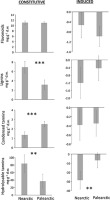当前位置:
X-MOL 学术
›
Phytochemistry
›
论文详情
Our official English website, www.x-mol.net, welcomes your feedback! (Note: you will need to create a separate account there.)
Assessing the influence of biogeographical region and phylogenetic history on chemical defences and herbivory in Quercus species
Phytochemistry ( IF 3.8 ) Pub Date : 2018-09-01 , DOI: 10.1016/j.phytochem.2018.06.002 Xoaquín Moreira , Luis Abdala-Roberts , Andrea Galmán , Marta Francisco , María de la Fuente , Ana Butrón , Sergio Rasmann
Phytochemistry ( IF 3.8 ) Pub Date : 2018-09-01 , DOI: 10.1016/j.phytochem.2018.06.002 Xoaquín Moreira , Luis Abdala-Roberts , Andrea Galmán , Marta Francisco , María de la Fuente , Ana Butrón , Sergio Rasmann

|
Biogeographical factors and phylogenetic history are key determinants of inter-specific variation in plant defences. However, few studies have conducted broad-scale geographical comparisons of plant defences while controlling for phylogenetic relationships, and, in doing so, none have separated constitutive from induced defences. This gap has limited our understanding of how historical or large-scale processes mediate biogeographical patterns in plant defences since these may be contingent upon shared evolutionary history and phylogenetic constraints. We conducted a phylogenetically-controlled experiment testing for differences in constitutive leaf chemical defences and their inducibility between Palearctic and Nearctic oak species (Quercus, total 18 species). We induced defences in one-year old plants by inflicting damage by gypsy moth larvae (Lymantria dispar), estimated the amount of leaf area consumed, and quantified various groups of phenolic compounds. There was no detectable phylogenetic signal for constitutive or induced levels of most defensive traits except for constitutive condensed tannins, as well as no phylogenetic signal in leaf herbivory. We did, however, find marked differences in defence levels between oak species from each region: Palearctic species had higher levels of constitutive condensed tannins, but less constitutive lignins and less constitutive and induced hydrolysable tannins compared with Nearctic species. Additionally, Palearctic species had lower levels of leaf damage compared with Nearctic species. These differences in leaf damage, lignins and hydrolysable (but not condensed) tannins were lost after accounting for phylogeny, suggesting that geographical structuring of phylogenetic relationships mediated biogeographical differences in defences and herbivore resistance. Together, these findings suggest that historical processes and large-scale drivers have shaped differences in allocation to constitutive defences (and in turn resistance) between Palearctic and Nearctic oaks. Moreover, although evidence of phylogenetic conservatism in the studied traits is rather weak, shared evolutionary history appears to mediate some of these biogeographical patterns in allocation to chemical defences.
中文翻译:

评估生物地理区域和系统发育历史对栎属植物化学防御和食草性的影响
生物地理因素和系统发育历史是植物防御中种间变异的关键决定因素。然而,很少有研究在控制系统发育关系的同时对植物防御进行了大规模的地理比较,并且在这样做时,没有人将组成型防御与诱导防御分开。这种差距限制了我们对历史或大规模过程如何调节植物防御中的生物地理模式的理解,因为这些可能取决于共享的进化历史和系统发育限制。我们进行了系统发育控制的实验,测试了古北和近北橡树种(栎属,共 18 种)之间组成性叶子化学防御及其诱导性的差异。我们通过对吉普赛蛾幼虫 (Lymantria dispar) 造成损害来诱导一岁植物的防御,估计消耗的叶面积量,并量化各种酚类化合物组。除了组成型浓缩单宁外,大多数防御性状的组成型或诱导水平没有可检测的系统发育信号,叶食草动物也没有系统发育信号。然而,我们确实发现每个地区的橡树物种之间的防御水平存在显着差异:与近北物种相比,古北物种具有更高水平的组成型缩合单宁,但组成型木质素较少,组成型和诱导水解单宁较少。此外,与近北区物种相比,古北区物种的叶片损伤程度较低。这些叶片损伤的差异,在考虑到系统发育后,木质素和可水解(但未浓缩)的单宁丢失了,这表明系统发育关系的地理结构介导了防御和食草动物抗性的生物地理差异。总之,这些发现表明,历史过程和大规模驱动因素影响了古北区和近北区橡树之间本构防御(进而抵抗)的分配差异。此外,尽管所研究性状的系统发育保守性证据相当薄弱,但共同的进化史似乎在化学防御分配中调节了其中一些生物地理学模式。表明系统发育关系的地理结构介导了防御和食草动物抵抗的生物地理差异。总之,这些发现表明,历史过程和大规模驱动因素影响了古北区和近北区橡树之间本构防御(进而抵抗)的分配差异。此外,尽管所研究性状的系统发育保守性证据相当薄弱,但共同的进化史似乎在化学防御分配中调节了其中一些生物地理学模式。表明系统发育关系的地理结构介导了防御和食草动物抵抗的生物地理差异。总之,这些发现表明,历史过程和大规模驱动因素影响了古北区和近北区橡树之间本构防御(进而抵抗)的分配差异。此外,尽管所研究性状的系统发育保守性证据相当薄弱,但共同的进化史似乎在化学防御分配中调节了其中一些生物地理学模式。
更新日期:2018-09-01
中文翻译:

评估生物地理区域和系统发育历史对栎属植物化学防御和食草性的影响
生物地理因素和系统发育历史是植物防御中种间变异的关键决定因素。然而,很少有研究在控制系统发育关系的同时对植物防御进行了大规模的地理比较,并且在这样做时,没有人将组成型防御与诱导防御分开。这种差距限制了我们对历史或大规模过程如何调节植物防御中的生物地理模式的理解,因为这些可能取决于共享的进化历史和系统发育限制。我们进行了系统发育控制的实验,测试了古北和近北橡树种(栎属,共 18 种)之间组成性叶子化学防御及其诱导性的差异。我们通过对吉普赛蛾幼虫 (Lymantria dispar) 造成损害来诱导一岁植物的防御,估计消耗的叶面积量,并量化各种酚类化合物组。除了组成型浓缩单宁外,大多数防御性状的组成型或诱导水平没有可检测的系统发育信号,叶食草动物也没有系统发育信号。然而,我们确实发现每个地区的橡树物种之间的防御水平存在显着差异:与近北物种相比,古北物种具有更高水平的组成型缩合单宁,但组成型木质素较少,组成型和诱导水解单宁较少。此外,与近北区物种相比,古北区物种的叶片损伤程度较低。这些叶片损伤的差异,在考虑到系统发育后,木质素和可水解(但未浓缩)的单宁丢失了,这表明系统发育关系的地理结构介导了防御和食草动物抗性的生物地理差异。总之,这些发现表明,历史过程和大规模驱动因素影响了古北区和近北区橡树之间本构防御(进而抵抗)的分配差异。此外,尽管所研究性状的系统发育保守性证据相当薄弱,但共同的进化史似乎在化学防御分配中调节了其中一些生物地理学模式。表明系统发育关系的地理结构介导了防御和食草动物抵抗的生物地理差异。总之,这些发现表明,历史过程和大规模驱动因素影响了古北区和近北区橡树之间本构防御(进而抵抗)的分配差异。此外,尽管所研究性状的系统发育保守性证据相当薄弱,但共同的进化史似乎在化学防御分配中调节了其中一些生物地理学模式。表明系统发育关系的地理结构介导了防御和食草动物抵抗的生物地理差异。总之,这些发现表明,历史过程和大规模驱动因素影响了古北区和近北区橡树之间本构防御(进而抵抗)的分配差异。此外,尽管所研究性状的系统发育保守性证据相当薄弱,但共同的进化史似乎在化学防御分配中调节了其中一些生物地理学模式。



























 京公网安备 11010802027423号
京公网安备 11010802027423号